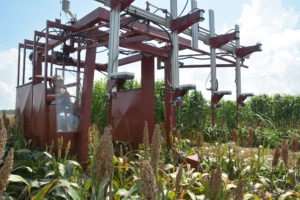By Kay Ledbetter
It’s been said a picture is worth a thousand words. But for Dr. Seth Murray, the images captured by an unmanned aerial vehicle or self-propelled ground vehicle could be worth more than a thousand man hours.

The images can then lead to the selection of the next higher yielding crop variety, not in 10 years, but over two or three years.
Murray, a Texas A&M AgriLife corn breeder in the soil and crop science department of Texas A&M University at College Station, said the world of genomics and DNA markers has been around for 30 years, but only recently have they been routinely incorporated into the breeding programs.
Genomics allows researchers to identify genetic locations in plants exhibiting certain phenotypic traits they need to improve production.
But what is needed now is more development of high-throughput field phenotyping, or HTFP, tools for the next generation of plant breeding, Murray said.
Working with large teams of faculty, staff and students from across the Texas A&M system, he said his current project is to develop analysis methods and software that will allow HTFP data collection to aid in his breeding decisions.
Two of Murray’s graduate students are working to confirm genes that relate to plant height.
“Individual genes have small effects and it is hard for us to accurately measure those changes. With this, we could measure that and see, ‘Do these genes actually work?’”
Murray’s research project includes a first-of-its-kind high-clearance, self-propelled ground vehicle built to include all the sensors he needed. It has ultrasonic sensors that use sound waves to measure height.
Murray said they needed an upgradable sensor payload to measure multiple variables of plant growth and development across the many different breeding programs at Texas A&M. The vehicle has a 10–foot clearance with high stability to phenotype corn, sorghum and other row crops through maturity without disrupting the crop.
Additionally, the ground vehicle has active sensors for measuring normalized difference vegetation index, or NDVI, infrared thermometers to measure the ground and crop temperatures and a weather station to measure air temperature and wind speed.
All that information is fed into a data logger, combined with a real time kinematic or RTK GPS signal, to precisely tell where that machine is and what it is measuring.
“We had our machine custom made because corn grows so tall,” he said. “We are in the process of writing the analysis code. By the end of this year we will know whether it can do what we need it to do.”
He said they’ve also had the fixed-wing plane fly all the fields involved in one experiment with corn and sorghum, taking measurements once a week.
Click here to see more...